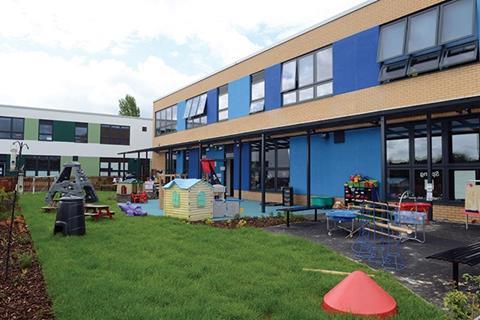The government’s flagship programme to regenerate the schools estate has just seen the start of its second phase. Ike Ijeh assesses what the Priority School Building Programme has offered pupils and the construction industry so far

It has been a long wait – but the second phase of the coalition government’s flagship Priority School Building Programme (PSBP) is now under way. The launch of the first schemes to market, just before Christmas, came almost two years after the list of 277 schools set to be upgraded in the second tranche of the initiative was announced in February 2015. Launched in 2011 as a replacement for the £55bn Building Schools for the Future (BSF) programme, the £4bn PSBP is set to run until 2021 with the aim of rebuilding or refurbishing a total of 537 primary, secondary and special education needs schools across England.
There are several features, aside from the obvious gulf in headline budgets, that distinguish PSBP from BSF. PSBP relies heavily on standardisation in order to rationalise design and keep costs down. It is delivered by a central management body, the Education Funding Agency (EFA), which also promotes a common standard – a “facilities output specification” – that imposes a series of physical, spatial and layout consistencies on school buildings with regard to elements like classroom and corridor sizes; with a suggested interpretation of those standards provided by the EFA through a set of baseline designs.
While the majority of PSBP schools are delivered by capital funding, the remainder are financed by a private finance model (PF2), known as the “aggregator model”, because it enables funding for the batches that include the 46 PF2 schools to be combined, allowing them to access cheaper finance.
While the Department for Education (DfE) insists PSBP has cut school construction costs by 20%, there are others who point to higher long-term maintenance costs and argue that the project has been hindered by funding gaps. Equally, while the EFA maintains that the baseline designs, and the set of output specifications on which they are based, promote design flexibility, others, particularly architects, have argued that the opposite is the case and that PSBP has led to a weakening of design quality and a “cut-price” approach to architecture. So, as PSBP Phase 2 gets under way, we assess how the PSBP programme has performed in some key areas and what that means for Phase 2.
Design
While there are many who insist that high-quality design does not always mean high cost, there is a stubbornly popular school of thought that believes the opposite, seeing attention to aesthetically pleasing design as symptomatic of excess and overspend. This latter group will perhaps be satisfied in the lack of architectural flourish in PSBP schools. Shortly after a school building procured under BSF – Burntwood School in south-west London – won the 2015 Stirling prize, a RIBA report into the state of the school estate criticised the restrictiveness of the approach taken to design under the PSBP, saying: “The EFA has succeeded in delivering schools to incredibly tight budgets, but it has also proved to be hugely restrictive in terms of the design and timeframes allowed for the construction of new schools. This one-size-fits-all approach means opportunities to innovate or respond to local context to optimise investment are curtailed.”

Nobody would seriously maintain that PSBP has produced exceptional architecture. The EFA is concerned, not with how many architecture awards the programme clocks up, but whether it produces schools that are “fit for purpose”. Here, the verdict varies. The first ever PSBP school, Whitmore Park in Coventry, provides a good example of the design approach that pervades the entire PSBP venture. With its flat, boxy elevations and general air of dour diffidence throughout, Whitmore Park is never going to win any beauty parades. But with its large windows and efficient spatial layout it has undoubtedly created a pleasant and appropriate teaching environment. Is that enough to constitute good design? Many will differ but for PSBP it’s clearly good enough. The overall approach to design that will characterise Phase 2 will be along the same lines, but Mike Green, the EFA’s director of capital, confirmed to Building this week that the facilities output specification – which details the standards that schools must be designed to – was being “looked at again from top to bottom”, with the detail subject to change to take account of any issues identified in the first phase.
Modular construction
In a recent Building interview, the EFA’s Green confirmed he would like to see an expansion of modular construction techniques in carrying out PSBP Phase 2 and spoke with pride about how the modular challenge had been tackled during PSBP’s first phase. “We’ve just about cracked it. We’ve got concrete floors, we’ve got schools that don’t look like modular buildings … It’s an area where I think we’re coming on really quickly.”

So will the use of off-site manufacture increase? Richard Crosby, director of education at management consultant Blacc and an independent consultant to the EFA, believes PSBP Phase 2 can address any supply issues. He says: “I see modular construction playing an even bigger role in PSBP2; in fact Phase 2 represents one of the biggest opportunities for modular construction in the market. The EFA understands the need to design and procure for off-site construction and they are working on a component solution of standard blocks that can be assembled to create bespoke schools without compromising on quality of design or specification. The EFA’s modular schools will look and feel like traditional build schools in a fraction of the time on site.”
Crosby also maintains that the volumetric modular systems that have made such recent and significant inroads in low-cost housing construction will also be more apparent with PSBP Phase 2. “The fact that schools are much bigger and more complex buildings than houses has been a challenge but this type of construction makes sense as it minimises disruption to live learning environments and offers reduced construction periods. Also, classroom sizes are fairly constant on most schools, so it allows a consistent approach to design and manufacture. The results of how the EFA has responded to this challenge will be seen in the forthcoming procurements.”
Costs
Reduced costs were said to be one of the key advantages of PSBP and the DfE has been keen to trumpet the 20% reduction in costs the programme has realised over BSF.
However, inflationary pressures have been largely blamed for an overspend of £178m. At the time the DfE cited “growing evidence of a significant increase in demand for construction capacity leading to cost pressure to deliver the programme in the agreed timeframe and capital budget.”
It also laid some of the blame for the overspend on “external factors” such as the sluggish “recovery of the construction market”.
It is a position Jonathan Stewart, main board director at property consultant Gleeds, can sympathise with.

“Brexit, supply and demand pressures and inflation have affected the entire property development sector. Nobody predicted these would be at the kind of levels they are now,” he says. “So this kind of overspend is not wholly unusual, particularly in the public sector.”
Stewart, however, does have a number of recommendations for how PSBP Phase 2 can insulate itself from further market volatility. “Contingencies to allow for rising inflation would help. Also, phasing should be carefully managed and temporary accommodation costs should be closely scrutinised. These are the kind of areas where costs can rise. This will be particularly important for PSBP Phase 2 where refurbishment, with all its attendant unpredictability, will be playing a bigger role.”
For Blacc’s Crosby the accelerated incorporation of modular construction systems is key to ensuring that PSBP Phase 2 delivers the cost savings it promises. He says: “To date the EFA has delivered modular schools within the EFA’s funding allowance.
“With work undertaken on the development in design and procurement for manufacture it is possible to drive even better value and the EFA are confident this can be delivered with shorter construction times and better quality.”
Procurement
Whereas Priority Schools Phase 1 was procured through a mix of capital funding and PF2, Phase 2 stands to be exclusively delivered through capital funding. Gleeds’ Stewart believes this is likely to prove more appropriate for the mix of projects, which contains more refurbishment schemes than the first phase.
He says: “Refurbishment is more complex and less predictable so it is likely that procurement will have to adapt to this. Also, even though the PF2 model has performed well against the capital-funded projects in terms of time and costs, it might not be appropriate for refurbishment as the private sector may be less willing to bear the risk.”
PSBP typically involves school projects being grouped together into batches on which competing contractors bid. The batches are determined by geography and commercial viability. The DfE believes that the batch approach drives competition, renders the projects more commercially attractive, and allows for cost savings and more efficient construction programmes.
Stewart maintains that the procurement model for PSBP is an improvement on previous arrangements, including BSF, which produced some notorious examples of protracted procurement and high bid costs.
“It’s generally a good step up and is a quicker and much more streamlined process,” he says.
However, he believes that one of the key challenges in ensuring that the procurement model for PSBP Phase 2 works has more framework options in order to trigger greater competition between contractors than there has been in Phase 1, which has seen the capital projects procured through centrally managed EFA frameworks. “There hasn’t always been the required level of interest from contractors. Much of this is dependent on market conditions and supply and demand – if there’s lots of work around contractors will flood back but if there isn’t they are more likely to weigh up their options,” he says.

“So having lots of framework options could be a good way of generating more interest and tapping into the market.
“Willmott Dixon’s new Scape framework is a good example because this offers several options and not just one.”
It seems that the EFA is on board with this philosophy of greater procurement options. Green told Building this week that the EFA was piloting a “local delivery model”, under which local authorities or multiple academy trusts procure buildings to EFA standards. It is understood that more than 70 school projects under Phase 2 have been made part of this model.
Meanwhile, contractors will be closely watching the reprocurement of the EFA’s own frameworks, due shortly. One change the EFA is introducing is to carry out feasibility studies on schools earlier in the process.
Green said: “We’re trying to start schools earlier, doing the feasibility earlier so that we understand what the issues schools have are, ahead of the main construction timeline. That will make it easier to stay on programme.”
But Stewart is mostly satisfied with the achievements of PSBP Phase 1 and is hopeful about how its successor will perform.
“I think it’s generally met its core ambitions of delivering schools at cheaper cost and over less time. Yes there are some unhappy stakeholders but this is always the case and it has certainly proved cheaper than previous programmes. It delivers what it needs to which is schools that are adequate to fit their purpose.”



























No comments yet